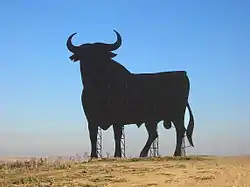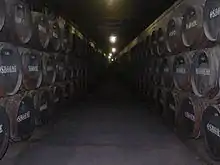Osborne bull
The Osborne bull (Spanish: Toro de Osborne) is a 14-metre (46 ft) high black silhouetted image of a bull in semi-profile. There are at least 90 of them located outdoors all over Spain.

History
The Osborne sherry company (founded by Thomas Osborne Mann in 1772) erected large images of bulls starting in 1956 to advertise their Brandy de Jerez.[1] The images were black (with the brand "Veterano" in red on it) advertising boards located near major roads throughout Spain. The original image was smaller and slightly different in design. The current larger image was created to comply with a law that prohibited advertising within 150 metres of a road.
In 1994 a law that prohibited all roadside advertising of alcoholic beverages came into effect and the bulls were therefore to be removed. By this time the signs were nationally renowned and public response resulted in the signs being retained but all references to the original advertisers being removed. The Court eventually allowed these signs to remain on the grounds that they have become a part of the landscape and have "aesthetic or cultural significance", thus turning the bulls into public domain images.
Only two signs remain in Spain with the word "Osborne" still written on them. One is at the Jerez de la Frontera airport in the province of Cadiz, and the other is in the nearby town of El Puerto de Santa María, where the Osborne headquarters is based.
The image of the bull has become widely known and can be found on stickers, post cards and other items. It has become a wider symbol for Spain by sports fans where the bull is embedded in the Flag of Spain in the manner of a coat of arms.
There are about 90 examples of the Osborne bull advertisements. A few of them are also present, in a slightly different design, in Mexico, where it retains its advertising function.[2]
The only bull in the Barcelona province was vandalized by people who identified themselves as Catalan independentists. Later it was restored by a group of neighbours of Masquefa,[3] until it was finally demolished eight months later.[4] The only Bull in Mallorca is often vandalized due to independentist or other[5] movements.
 Brandy de Jerez barrels at Osborne headquarters
Brandy de Jerez barrels at Osborne headquarters Flag of Spain with an Osborne bull
Flag of Spain with an Osborne bull
References
- Johnson, Carla; Leatherman, Alyson (2005). "El Toro de Osborne: advertising, community, and myth". The Social Science Journal. 42: 135–140. doi:10.1016/j.soscij.2004.11.012.
- Article in El País commemorating the bull's 50th anniversary, in Spanish
- Reaparece en el Bruc la silueta del toro (in Spanish)
- "El toro del Bruc ja torna a ser a terra". Regió 7. 24 February 2009. Retrieved 24 September 2019.
- El único toro de Osborne de Mallorca lleva 15 días pintado con la bandera gai Bull painted in LGBT rainbow colours
External links
| Wikimedia Commons has media related to Toros de Osborne. |
- Spanish national flag with the Osborne bull : Images from Flags of the World.
- Grupo Osborne, the sherry company
- Spain's biggest bullfight: The militant Catalans waging war against the 'Osborne bulls', The Independent, 6 August 2007